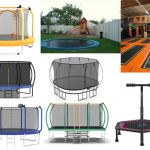- 1-The-Concept-of-Bouncing-as-a-Task-Reset
- 2-Benefits-of-Bouncing-Breaks-for-Productivity
- 3-How-to-Incorporate-Bouncing-Into-Your-Workday
- 4-Real-Life-Examples-of-Bouncing-Used-as-a-Reset
- 5-Trampoline-Zone-Resources-for-Bouncing-Breaks
1. The Concept of Bouncing as a Task Reset
In today’s fast-paced work environment, maintaining focus and energy throughout the day can be challenging. One innovative technique gaining attention is how to use bouncing as a reset between tasks. This approach involves taking short breaks involving gentle bouncing movements, often on a mini trampoline or rebounder, to refresh the mind and body before moving on to the next task.
Bouncing as a reset taps into the natural rhythm and motion of the body, encouraging circulation, releasing tension, and signaling the brain to switch gears. Unlike sedentary breaks, bouncing actively engages muscles and improves alertness.
1.1 Why Bouncing Works as a Mental and Physical Reset
Movement stimulates the brain’s neural pathways, promoting clearer thinking and reducing mental fatigue. The rhythmic nature of bouncing also fosters a calming effect, helping reduce stress levels and improve mood.
2. Benefits of Bouncing Breaks for Productivity
Incorporating bouncing breaks between tasks offers several advantages that contribute to better work performance and well-being.
2.1 Enhanced Focus and Concentration
Short bouts of bouncing increase blood flow to the brain, leading to sharper concentration when returning to work.
2.2 Boosted Energy and Reduced Fatigue
Unlike caffeine or sugary snacks, bouncing provides a natural energy boost without the crash, helping sustain productivity.
2.3 Stress Relief and Improved Mood
Physical movement triggers the release of endorphins, which can lighten mood and lower stress, creating a more positive work environment.
3. How to Incorporate Bouncing Into Your Workday
Implementing bouncing as a reset is simple and adaptable to various work settings.
3.1 Choose the Right Equipment
A mini trampoline or rebounder designed for stability and comfort is ideal. Devices from trusted providers like Trampoline Zone offer safety features suitable for indoor use.
3.2 Schedule Regular Breaks
Set reminders to take 3–5 minute bouncing breaks every hour or after completing a major task to refresh your mind.
3.3 Combine with Breathing or Stretching
Enhance the benefits by pairing bouncing with deep breathing exercises or gentle stretches to further reduce tension.
4. Real-Life Examples of Bouncing Used as a Reset
At a busy tech company, employees began using short trampoline breaks to combat afternoon slumps. One developer shared, “Just five minutes of bouncing helped me reset mentally and come back with fresh ideas.” This practice spread organically, improving overall team productivity.
Similarly, a freelance writer incorporated bouncing breaks between research and writing sessions, noting a significant reduction in eye strain and mental fatigue.
5. Trampoline Zone Resources for Bouncing Breaks
For anyone curious about how to use bouncing as a reset between tasks, Trampoline Zone provides a range of quality rebounders and expert advice. Their products are designed to be safe, compact, and easy to use in home or office environments.
Beyond equipment, Trampoline Zone offers tips and instructional content to help users maximize the benefits of bouncing breaks, making it a practical tool for improving focus, energy, and well-being during the workday.
Embracing bouncing as a reset is a simple yet powerful way to enhance daily productivity, and with resources from Trampoline Zone, integrating this habit into your routine is easier than ever.







 Pump It Up Lake Forest Kids Birthday and More4.0 (280 reviews)
Pump It Up Lake Forest Kids Birthday and More4.0 (280 reviews) Urban Air Trampoline and Adventure Park4.0 (349 reviews)
Urban Air Trampoline and Adventure Park4.0 (349 reviews) Church Street Plaza4.0 (731 reviews)
Church Street Plaza4.0 (731 reviews) Fun City Adventure Park3.0 (162 reviews)
Fun City Adventure Park3.0 (162 reviews) Riki Tiki's Indoor PlayGround4.0 (35 reviews)
Riki Tiki's Indoor PlayGround4.0 (35 reviews) Urban Youth Park - South Bay4.0 (107 reviews)
Urban Youth Park - South Bay4.0 (107 reviews) Are Trampoline Parks Safe for Kids? Essential Guide for U.S. Parents
Are Trampoline Parks Safe for Kids? Essential Guide for U.S. Parents How Often Should You Replace Trampoline Springs? Tips for Proper Maintenance
How Often Should You Replace Trampoline Springs? Tips for Proper Maintenance How Much Is a Trampoline? A Detailed Guide to Trampoline Costs and Buying Tips
How Much Is a Trampoline? A Detailed Guide to Trampoline Costs and Buying Tips Bounce Techniques for Stronger Legs: Effective Exercises and Tips
Bounce Techniques for Stronger Legs: Effective Exercises and Tips Essential Music Gear for Trampoline Dance: Complete Guide
Essential Music Gear for Trampoline Dance: Complete Guide Fun STEM Experiments Using Trampolines to Spark Curiosity and Learning
Fun STEM Experiments Using Trampolines to Spark Curiosity and Learning